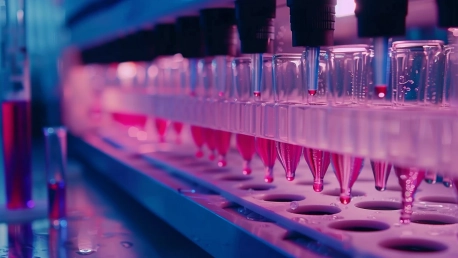The biotech industry in 2024 presents a stark contrast. On one hand, a surge of startups is enjoying robust financial support and offering abundant job opportunities. On the other hand, major established companies are grappling with significant layoffs and restructuring efforts. This juxtaposition has led industry observers to describe the sector as being divided into “haves” and “have-nots” when it comes to access to capital and success in drug development. This division has resulted in a complex landscape where understanding the broader context is crucial to grasping the current state of the industry.
Booming Biotech Startups
Biotech startups are attracting impressive levels of investment, with $3 billion in funding secured in just the first quarter of 2024. These new ventures are injecting vitality into regions like the Greater Boston area, creating numerous job opportunities and fostering innovation. The influx of capital is not just a sign of confidence in the sector but also a reflection of the potential seen in next-generation biotech solutions. Investors are particularly interested in startups focusing on cutting-edge areas such as gene editing, personalized medicine, and new therapeutic approaches.This enthusiasm has led to a proliferation of new companies, many of which are spinning out of academic institutions and research hospitals. These startups are not only well-funded but also positioned at the forefront of technological advancements, poised to revolutionize various aspects of healthcare and medicine. The success of these startups is creating a robust job market, especially for researchers, scientists, engineers, and other skilled professionals. For cities like Boston, this surge translates to a thriving local economy supported by a highly specialized workforce, attracting talent from across the globe.The abundance of job openings suggests a vibrant, dynamic sector that is flourishing amid broader economic uncertainties. The Greater Boston area, home to numerous world-renowned universities and research institutions, has become a magnet for biotech talent and investment. Startups in this region are leveraging local expertise, resources, and collaboration opportunities to drive significant advancements in the field. This thriving ecosystem is indicative of a broader trend of innovation and growth within the startup segment of the biotech industry.
Layoffs at Major Firms
In stark contrast to the booming startup scene, several major biotech and pharmaceutical companies are undergoing significant layoffs. These cuts have impacted renowned names like Amylyx Pharmaceuticals, Novartis, Genentech, and Sanofi. These layoffs, part of broader restructuring efforts, reflect a sector in turmoil at the higher echelons. For instance, Novartis announced significant personnel reductions, particularly at its San Diego research site, as part of a wave of restructuring that began earlier in the year. Similarly, Takeda has undertaken multiple rounds of layoffs, reflecting the company’s strategic shift and operational realignments. These job cuts are not isolated incidents but part of a larger trend affecting many established players in the industry.Several factors drive these layoffs, ranging from disappointing clinical trial results to competitive market pressures and strategic pivots. Companies like Indivior and CureVac have had to reduce their workforce significantly after encountering substantial challenges in their respective therapeutic areas. Even companies like Aerovate Therapeutics and GeNeuro, which had promising projects, faced severe cuts following unsuccessful clinical trials. The layoffs at major firms are indicative of broader industry dynamics where established companies are struggling to maintain their competitive edge in an increasingly challenging environment.The impact of these layoffs extends beyond the immediate loss of jobs. They signal deeper issues within these companies, such as difficulties in securing funding, inefficiencies in operations, or misalignment with market demands. These challenges underscore the complexity of sustaining success in the biotech sector, particularly for larger, more established firms. The contrasting fortunes of startups and major firms highlight the nuanced and multifaceted nature of the current biotech landscape.
Drivers of Workforce Reductions
The root causes of these widespread layoffs are multifaceted. Failures in clinical trials have led to the discontinuation of several drug development programs, forcing companies to downsize. For instance, Amylyx Pharmaceuticals had to cut 70% of its workforce after clinical trial failures, underscoring the high-risk nature of the biotech sector. Another driver is the strategic refocusing of companies towards more promising or commercially viable projects. This process often involves significant restructuring, including job cuts. Companies like Barinthus Biotherapeutics exemplify this trend, opting to prioritize resources on their most promising drug candidates while trimming their workforce.Operational reorganization aims to streamline efforts and enhance efficiency, often at the cost of jobs. Large and mid-sized companies are continually adjusting their operations to remain competitive, as evidenced by the extensive layoffs at Genentech and Pfizer. These strategic realignments are necessary for long-term sustainability but can be painful in the short term. The emphasis on operational efficiency highlights the increasing pressure on companies to optimize their resources and focus on high-impact areas.These layoffs are not merely reactive measures but part of larger strategic realignments aimed at ensuring long-term viability. For instance, companies may be pivoting to focus on areas with higher potential returns or consolidating operations to reduce redundancy. While such moves are essential for adapting to market dynamics, they also underscore the inherent volatility and uncertainty in the biotech sector. Understanding these drivers is crucial for comprehending the broader trends shaping the industry and anticipating future developments.
Regional and Sectoral Impact
The impact of these layoffs is not evenly distributed and varies significantly by region and sector. Areas like Massachusetts and California have been particularly hard-hit. The Boston-Cambridge corridor, a hub for biotech activity, has seen numerous layoffs despite its otherwise buoyant job market driven by startups. A similar situation exists in California, where major companies are slashing jobs even as the startup ecosystem flourishes. Certain therapeutic sectors are more affected than others. For example, oncology has seen notable cutbacks, with companies like 2seventy Bio and Freenome laying off significant portions of their workforce.Similarly, the neurology and CNS disorders segment is experiencing substantial reductions, with companies like Biogen and Amylyx Pharmaceuticals implementing deep cuts. The regional disparities in the impact of layoffs highlight the concentrated nature of biotech activity in certain hubs. These areas, despite their vibrant ecosystems, are not immune to the broader industry challenges. The sectoral differences in layoffs also emphasize the varying degrees of vulnerability and opportunity within different therapeutic areas.Internationally, countries like Germany and Switzerland are feeling the impact as well, with companies such as Roche and CureVac announcing job cuts. In China, LianBio’s downsizing highlights that the trend is not confined to the Western hemisphere but is a global phenomenon. The global nature of these layoffs indicates widespread pressures affecting the biotech industry across different markets. These pressures are driven by common factors such as funding challenges, market competition, and strategic shifts, underscoring the interconnectedness of the global biotech landscape.
Future Trends and Adaptations
The biotech industry in 2024 presents a significant contrast between emerging startups and established giants. On one side, new startups are thriving, receiving substantial financial backing and creating numerous job opportunities. These companies are capitalizing on innovative research and development, attracting investors eager to support groundbreaking advancements. Their success stories and rapid growth paint a picture of excitement and optimism within the biotech community.In stark contrast, many major established companies are experiencing tough times, marked by significant layoffs and restructuring measures. These organizations face challenges in maintaining their market position and securing funding. The pressure to develop new drugs and bring them to market has proven to be a formidable hurdle for these giants. This disparity has led industry observers to describe the sector as being divided into “haves” and “have-nots,” highlighting the uneven distribution of capital and success.This division has created a complex landscape that demands a deeper understanding of the broader context to grasp the current state of the industry fully. The biotech sector’s evolution is now characterized by this juxtaposition: while innovative startups soar, established firms struggle to adapt to an ever-changing market. Stakeholders, including investors, employees, and policymakers, must navigate this intricate environment, balancing the promise of innovative startups with the challenges facing traditional biotech powerhouses.









